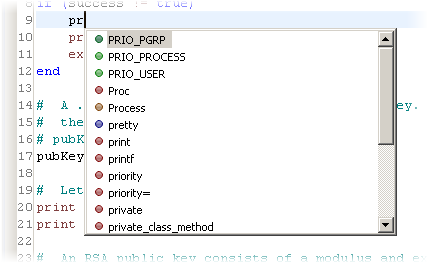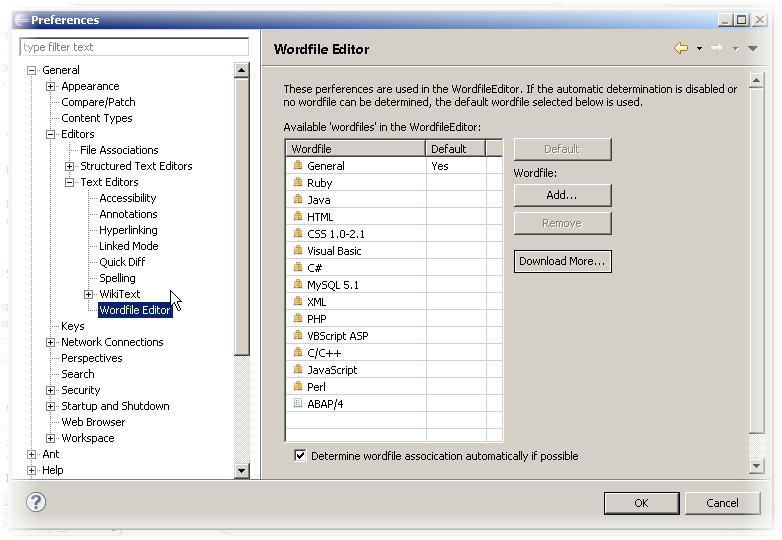Contents
Installation
Prerequisites
The following prerequisites have to be met, to be able to install this plugin:
- Requires Java 1.6 or higher.
- Requires Eclipse IDE for Java Developers 3.4 or higher.
Marketplace
Use the automatic installation of your Eclipse Helios or Indigo release.
To install it on Eclipse 3.6 (Helios) and 3.7 (Indigo):
- Open Help ► Eclipse Marketplace... .
- Enter "WFE Wordfile Editor" in the text box labeled "Find" at the top of the dialog.
- Press Return or click the Find-Button.
- Select the "WFE Wordfile Editor" entry from the list below.
- Click "Install" on the rightern side. Eclipse guides you through the remaining installation steps.
Update Site
To install it on any Eclipse 3.6 or greater:
- Open Help ► Install New Software... .
- Enter http://ksquared.de/wfe/eclipse/update in the text box labeled "Work with" at the top of the dialog.
- Select "Wordfile Editor" entry from the list below.
- Click "Next". Eclipse guides you through the remaining installation steps.
Editor
Open Editor
The editor is assgined to a lot of file extensions by default. As long as Eclipse does not offer any kind of dynamic file extension assignment the Wordfile Editor does not open automatically for some file types. Aswell if there is already another Editor registred to any file extension. So the Wordfile Editor may be assigned manually.
To open the Wordfile Editor for any file:
- Right click on the file you want to open.
- Select Open with ► Other... .
- Choose "Internal editors".
- Select the "Wordfile Editor" entry from the list below.
- Confirm the dialog with "OK".
Usage
Use the Wordfile Editor like a regular text editor. The Wordfile Editor tries to determine a maching wordfile automatically using the file extension. If any wordfile was found it is displayed in parentheses behind the file name at the top of the editor.

If you want to assign a wordfile manually or choose a different one, follow the instructions below.
Content Assist
The Wordfile Editor offers an enhanced content assist for all wordfile based languages. Therefore select or naviagte to any text position in the Wordfile Editor. After pressing the shortcut keys Ctrl + Space a content assist will appear. By typing any character you can filter the content assists results.

You can either select an entry by navigating using your arrow keys and the return key of your keyboard, or by using your mouse. The dialog can be closed, without choosing a word, using the escape key.
Code Folding
Code folding is only available for some wordfile configuration. If it is available any source code can be collapsed and expanded using plus and minus signs on the leftern side of the editor frame (annotations).

By clicking on any annotation, text in this area will be either hidden or displayed.
Change Markers
Red change makers on the leftern side of the editor indicate, which lines have been changed since the file was saved the last time.

Settings
File Properties
Wordfile file properties are important to change the default wordfile to use, when the Wordfile Editor is opened for this file. This property can be set to each file individually. Therefore multiple files with the same extension may open using different wordfiles.
To open the Wordfile Editor properties for any file:
- Right click on the file you want to open.
- Select Properties.
- Select the "Wordfile Settings" entry from the list.

Use the dialog to set all file specific properties. Using the drop down list, you can either choose a specific wordfile to be used each time the Wordfile Editor is opened with this file. Therefore select any wordfile from the list and confirm the dialog with "OK". Using the option "General" will disable the syntax highlighting and most of the assistant features for this file.
The option "Automatically select" is the default option for any file. The Wordfile Editor tries to determine a appropriate wordfile for a file automatically based on its filename.
General Preferences
To open the general peferences of the Wordfile Editor:
- Open Window ► Preferences.
- In the list choose and expand General ► Editors ► Text Editors.
- Select the "Wordfile Editor" entry from the list.

Manage Wordfiles
Any wordfile can be selected to be opened by default. Therefore select an entry from the list, and mark the entry by clicking on "Default". Some wordfiles have a lock displayed in front of the wordfile name. These wordfiles are build-in and can not be modified.
New wordfiles may be added by clicking the "Add..." button. Existing custom wordfiles can be removed by selecting the custom wordfile and clicking on "Remove".
If you want to download more wordfiles for the Wordfile Editor either click on "Download More..." or go to the IDM UltraEdit homepage. Any UltraEdit wordfile is compatible for using it in the Wordfile Editor.
Equivalent Wordfile Number
In some cases, when adding a custom wordfile, the message "There is already a default wordfile with an equivalent wordfile number. Please add another wordlist or change the number of this wordfile" or "There is already a custom wordfile with an equivalent wordfile number. Please add another wordlist or change the number of this wordfile" is displayed. You will not be able to add your wordfile to the Wordfile Editor.
To fix this, you will have to make a minor change to the wordfile you are trying to add. Following the standard specification of a wordfile, the wordfile is identified by a unqiue wordfile number. Open the wordfile in a text editor of your choice. In the first line you will notice the term /L followed by any number (e.g. /L12). Simply change this number to a number of your choice, save the change and you should be able to add the wordfile to the Wordfile Editor.
Automatic Assignment
By selecting the "Determine wordfile association automatically if possible", the Wordfile Editor tries to determine a wordfile automatically, if no explicit wordfile was chosen in the files' properties. If this entry is not selected, a file will be opened using the default wordfile.
